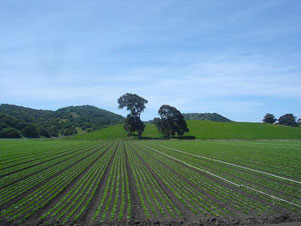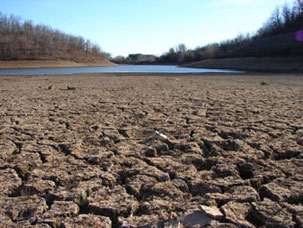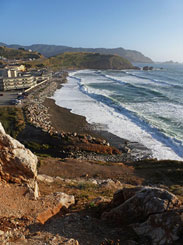Third National Climate Assessment

The biggest recent climate change news is the release of the third U.S. National Climate Assessment. This report is the definitive account of how climate change is affecting the U.S., by region and by sector, both now and in the future. The overwhelming conclusion is that climate change is no longer a distant threat, but is firmly in the present, with clear impacts in our daily lives and in every corner of the country. For the first time, the report findings are presented in an interactive, user-friendly website, highlighting the importance of clear communications. The report is getting a lot of press and attention nationally, and hopefully galvanizes a greater level of awareness and action everywhere.
In this issue of Currents we provide selected highlights from the Overview and key messages from the regional chapters on the SouthWest and Coasts which cover California.
From the Overview
Climate change, once considered an issue for a distant future, has moved firmly into the present. Corn producers in Iowa, oyster growers in Washington State, and maple syrup producers in Vermont are all observing climate-related changes that are outside of recent experience. So, too, are coastal planners in Florida, water managers in the arid Southwest, city dwellers from Phoenix to New York, and Native Peoples on tribal lands from Louisiana to Alaska. This National Climate Assessment concludes that the evidence of human-induced climate change continues to strengthen and that impacts are increasing across the country.
Americans are noticing changes all around them. Summers are longer and hotter, and extended periods of unusual heat last longer than any living American has ever experienced. Winters are generally shorter and warmer. Rain comes in heavier downpours. People are seeing changes in the length and severity of seasonal allergies, the plant varieties that thrive in their gardens, and the kinds of birds they see in any particular month in their neighborhoods.

Other changes are even more dramatic. Residents of some coastal cities see their streets flood more regularly during storms and high tides. Inland cities near large rivers also experience more flooding, especially in the Midwest and Northeast. Insurance rates are rising in some vulnerable locations, and insurance is no longer available in others. Hotter and drier weather and earlier snow melt mean that wildfires in the West start earlier in the spring, last later into the fall, and burn more acreage. In Arctic Alaska, the summer sea ice that once protected the coasts has receded, and autumn storms now cause more erosion, threatening many communities with relocation.
Scientists who study climate change confirm that these observations are consistent with significant changes in Earth’s climatic trends. Long-term, independent records from weather stations, satellites, ocean buoys, tide gauges, and many other data sources all confirm that our nation, like the rest of the world, is warming. Precipitation patterns are changing, sea level is rising, the oceans are becoming more acidic, and the frequency and intensity of some extreme weather events are increasing. Many lines of independent evidence demonstrate that the rapid warming of the past half-century is due primarily to human activities.
The observed warming and other climatic changes are triggering wide-ranging impacts in every region of our country and throughout our economy. Some of these changes can be beneficial over the short run, such as a longer growing season in some regions and a longer shipping season on the Great Lakes. But many more are detrimental, largely because our society and its infrastructure were designed for the climate that we have had, not the rapidly changing climate we now have and can expect in the future. In addition, climate change does not occur in isolation. Rather, it is superimposed on other stresses, which combine to create new challenges.
This National Climate Assessment collects, integrates, and assesses observations and research from around the country, helping us to see what is actually happening and understand what it means for our lives, our livelihoods, and our future. The report includes analyses of impacts on seven sectors – human health, water, energy, transportation, agriculture, forests, and ecosystems – and the interactions among sectors at the national level. The report also assesses key impacts on all U.S. regions: Northeast, Southeast and Caribbean, Midwest, Great Plains, Southwest, Northwest, Alaska, Hawai’i and Pacific Islands, as well as the country’s coastal areas, oceans, and marine resources.
Key Messages for the Southwest Region

- Snowpack and streamflow amounts are projected to decline in parts of the Southwest, decreasing surface water supply reliability for cities, agriculture, and ecosystems.
- The Southwest produces more than half of the nation’s high-value specialty crops, which are irrigation-dependent and particularly vulnerable to extremes of moisture, cold, and heat. Reduced yields from increasing temperatures and increasing competition for scarce water supplies will displace jobs in some rural communities.
- Increased warming, drought, and insect outbreaks, all caused by or linked to climate change, have increased wildfires and impacts to people and ecosystems in the Southwest. Fire models project more wildfire and increased risks to communities across extensive areas.
- Flooding and erosion in coastal areas are already occurring even at existing sea levels and damaging some California coastal areas during storms and extreme high tides. Sea level rise is projected to increase as Earth continues to warm, resulting in major damage as wind-driven waves ride upon higher seas and reach farther inland.
- Projected regional temperature increases, combined with the way cities amplify heat, will pose increased threats and costs to public health in southwestern cities, which are home to more than 90% of the region’s population. Disruptions to urban electricity and water supplies will exacerbate these health problems.
Key Messages for Coastal Regions

- Coastal lifelines, such as water supply and energy infrastructure and evacuation routes, are increasingly vulnerable to higher sea levels and storm surges, inland flooding, erosion, and other climate-related changes.
- Nationally important assets, such as ports, tourism and fishing sites, in already-vulnerable coastal locations, are increasingly exposed to sea level rise and related hazards. This threatens to disrupt economic activity within coastal areas and the regions they serve and results in significant costs from protecting or moving these assets.
- Socioeconomic disparities create uneven exposures and sensitivities to growing coastal risks and limit adaptation options for some coastal communities, resulting in the displacement of the most vulnerable people from coastal areas.
- Coastal ecosystems are particularly vulnerable to climate change because many have already been dramatically altered by human stresses; climate change will result in further reduction or loss of the services that these ecosystems provide, including potentially irreversible impacts.
- Leaders and residents of coastal regions are increasingly aware of the high vulnerability of coasts to climate change and are developing plans to prepare for potential impacts on citizens, businesses, and environmental assets. Significant institutional, political, social, and economic obstacles to implementing adaptation actions remain.
Local Government Commission Newsletters
Livable Places Update
CURRENTS Newsletter
CivicSpark™ Newsletter
LGC Newsletters
Keep up to date with LGC’s newsletters!
Livable Places Update – April
April’s article: Microtransit: Right-Sizing Transportation to Improve Community Mobility
Currents: Spring 2019
Currents provides readers with current information on energy issues affecting local governments in California.
CivicSpark Newsletter – March
This monthly CivicSpark newsletter features updates on CivicSpark projects and highlights.



